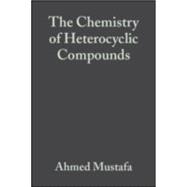The Chemistry of Heterocyclic Compounds, since its inception, has been recognized as a cornerstone of heterocyclic chemistry. Each volume attempts to discuss all aspects – properties, synthesis, reactions, physiological and industrial significance – of a specific ring system. To keep the series up-to-date, supplementary volumes covering the recent literature on each individual ring system have been published. Many ring systems (such as pyridines and oxazoles) are treated in distinct books, each consisting of separate volumes or parts dealing with different individual topics. With all authors are recognized authorities, the Chemistry of Heterocyclic Chemistry is considered worldwide as the indispensable resource for organic, bioorganic, and medicinal chemists.

The Chemistry of Heterocyclic Compounds, Volume 23 Furopyrans and Furopyrones
by Mustafa, Ahmed-

This Item Qualifies for Free Shipping!*
*Excludes marketplace orders.
Buy New
Rent Textbook
Rent Digital
Used Textbook
We're Sorry
Sold Out
How Marketplace Works:
- This item is offered by an independent seller and not shipped from our warehouse
- Item details like edition and cover design may differ from our description; see seller's comments before ordering.
- Sellers much confirm and ship within two business days; otherwise, the order will be cancelled and refunded.
- Marketplace purchases cannot be returned to eCampus.com. Contact the seller directly for inquiries; if no response within two days, contact customer service.
- Additional shipping costs apply to Marketplace purchases. Review shipping costs at checkout.
Summary
Author Biography
Ahmed Mustafa is the editor of The Chemistry of Heterocyclic Compounds, Volume 23: Furopyrans and Furopyrones, published by Wiley.
Table of Contents
I. Furopyrans and -pyrones 1
I. Naturally Occurring Furopyrans 2
1. Flumericin 2
2. Anhydrotetrahydroaucubigenin 9
II. Synthetic Furopyrans and-pyrones 11
III. References 13
II. Furocoumarins 14
I. Isolation 15
II. Physical Properties 32
III. Nomenclature 35
IV. Naturally Occurring Furocoumarins 35
1. Structure and Chemical Properties 35
A. Angelicin 36
B. Psoralen 38
C. Bergapten 41
D. Bergaptol 44
E. Isobergapten 44
F. Bergamottin 45
G. Xanthotoxin 46
H. Xanthotoxol 52
I. Isoimperatorin 52
J. Oxypeucedanin 52
K. Ostruthol 53
L. Imperatorin 55
M. Alloimperatorin 56
N. Heraclenin 56
O. Isopimpinellin 56
P. PheUopterin 58
Q. Byakangelicol 59
R. Byakangelicin 61
S. Pimpinellin 61
T. Sphondin 62
U. Halfordin and Isohalfordin 62
V. Nodakenetin 65
W. Peucedanin 69
X. Athamantin 70
Y. Discophoridin 72
Z. Edultin 73
AA. Peulustrin 73
BB. Columbianadin and Columbianin 76
CC. Archangelioin 77
DD. Archangelin 78
EE. Pyrocanesein 78
FF. 4,5',8-Trimethylpsoralen 79
GG. Aflatoxins B and G 79
2. Configuration 80
3. Biosynthesis 82
A. α-(/J'-Hydroxypropyl)dihydrofurans and a-Isopropenyl-dihydrofurans 83
B. α-IsopropyljS-hydroxyfurans and Relations 84
C. Simple Furans 86
4. Physiological Activity 87
V. References 90
III. Furochromones 102
I. Isolation 102
II. Physical Properties 103
III. Nomenclature 104
IV. Naturally Occurring Furochromones 104
1. Chemical Properties 104
A. Khellin 104
(1) Synthesis of khellin 107
(2) Synthesis of khellin analogs 112
(3) Reactions 112
B. Visnagin 133
(1) Synthesis of visnagin 134
(2) Synthesis of visnagin analogs and related transformations 136
(3) Reactions 138
C. Khellinol 143
D. Khetlinin 144
E. Khellol 145
F. Ammiol 147
G. Visamminol 148
2. Color Reactions 150
3. Physiological Activity 151
V. References 153
IV. Furoxanthones 160
I. Naturally Occurring Furoxanthones 160
1. Sterigmatocystin 160
II. Synthetic Furoxanthones 169
III. References 174
V. Furoflavones 175
I. Isolation 175
II. Physical Properties 175
III. Naturally Occurring Furoflavonee 183
1. Chemical Properties 183
A. Karanjin 183
B. LanoeolatinB 185
C. Pongapin 186
D. Kanjone 186
E. Pongaglabrone 188
F. Atanaain 190
G. Gamatin 190
H. Pinnatin 191
IV. Synthetic Furoflavones 193
1. Linear-type 192
2. Angular-type 195
V. References 198
VI. Furoisoflavanoids 301
I. Introduction 201
II. Furoisoflavanones 201
1. Naturally Occurring Furoisoflavanones 201
A. Nepseudin 201
B. Neotenone 218
2. Synthetic Furiosofiavanones 220
A. Angular Furoisoflavones 220
(1) Introduction of a furan nucleus into an isoflavone skeleton (Tanaka’s method) 220
(2) Ethyl orthoformate method (Venkataraman) 224
B. Linear Furo(3', 2'-6,7)isoflavones 226
III. Coumaranochromans 227
1. Introduction 227
2. Naturally Occurring Coumaranochromans 228
A. Homopterocarpin 228
B. Pterocarpin 230
C. Maackiain 233
D. Pisatin 234
E. Neodulin 236
F. Phaseollin 237
IV. Coumaronoflavan-4-ols 238
1. Naturally Occurring Coumaronoflavan-4-ols 238
A. Cyanomaclurin 238
2. Synthetio 11H-benzofuro(3,2-b)-l-benzopyran-11-ones 242
V. Coumaronocoumarins 243
1. Naturally Occurring Coumaronocoumarins 243
A. Coumestrol 243
B. Wedelolactone 246
C. Trifoliol 251
D. Medicagol 253
E. Psoralidin 254
VI. 3-Arylfurocoumarins 258
VII. Coumaronofurocoumarins 259
VIII Furo(3,2-c}-l-benzopyran-4-ones 261
IX. Physiological Activity 262
X. References 266
VII. Chromanochromanones (The Rotenoids) 272
I. Introduction 272
II. Nomenclature 272
III. Rotenone 277
1. Isolation 277
2. Physical Properties 277
3. Structure 278
A. Dehydrorotenol 283
B. Rotenol 289
4. Isomerization (The Isorotenones) 290
A. Isomeric Carbonyl Derivatives of Rotenone 292
B. Hydrogenation 292
C. Oxidation 293
5. Synthesis 295
6. Stereochemistry 300
A. Optical Activity 300
B. Configuration 301
7. Rotenolones, Rotenolols, Isorotenolones, and Isorotenolols 305
IV. Sumatrol 309
V. Malaccol 312
VI. Elliptone 314
VII. Amorphigenin 318
VIII. Dolineone 321
IX. Pachyrrhizone 322
X. References 324
VIII. Less Common Furopyrone Systems 328
I. Isogalloflavin 328
II. Enmein 330
III. References 335
Author Index 337
Subject Index 357
An electronic version of this book is available through VitalSource.
This book is viewable on PC, Mac, iPhone, iPad, iPod Touch, and most smartphones.
By purchasing, you will be able to view this book online, as well as download it, for the chosen number of days.
Digital License
You are licensing a digital product for a set duration. Durations are set forth in the product description, with "Lifetime" typically meaning five (5) years of online access and permanent download to a supported device. All licenses are non-transferable.
More details can be found here.
A downloadable version of this book is available through the eCampus Reader or compatible Adobe readers.
Applications are available on iOS, Android, PC, Mac, and Windows Mobile platforms.
Please view the compatibility matrix prior to purchase.
